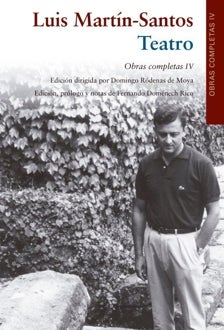Luis Martín-Santos, the playwright who could have been but wasn't

Luis Martín-Santos (1924-1964) is part of literary history thanks to his novel 'Tiempo de silencio' (Time of Silence), published in 1962, just two years before he died from injuries sustained in a car accident near Vitoria. His work as an essayist and poet was also well known, but the publication of the fourth volume of his ' Obras completas ' ( Galaxia Gutenberg ) has revealed a truly remarkable playwright, who, more than sixty years after his death, had his first premiere at the Teatro Español: ' Journey to the Limit '.

- Author Luis Martín Santos
- Edition, prologue and notes Fernando Doménech
- Editorial Gutenberg Galaxy
- Pages 336
- Price 23 euros
This work is one of the six pieces that make up this volume; they were discovered approximately a decade ago, but it wasn't decided to study and publish them until several years later. His heirs placed them in the hands of Fernando Doménech , who explains that the six texts—there may be more; Enrique Múgica remembered having read a work on Lope de Aguirre—are "in varying stages of completion: two of them are incomplete, one because it seems the author didn't finish it; another because it's missing the first page. All of them are typewritten, with corrections or additions by Martín-Santos. Two are dated. Three lack titles."
'Irma', a tragedy written in January 1946, when Martín-Santos was 21, is the first of the works included in the volume, which complete 'Los churros están fríos' (a piece without a title, to which Doménech himself gave a name), which is incomplete: only four pages; 'La novia que no se ve' (The Bride Who Can't Be Seen), a short, six-page work in a realist vein; 'Viaje hasta el límite' (Journey to the Limit) itself (dated December 1953); 'Claudia', a 59-page drama set among the upper bourgeoisie; and 'Olga', of which only sixteen pages remain, a light comedy in the wake of Enrique Jardiel Poncela and Miguel Mihura .
There is no doubt that the publication of these dramatic texts is a true event in itself, but they also demonstrate Luis Martín-Santos's potential as a playwright. In all his works, there is a perfect understanding of dramatic structure and architecture; a skill in creating conflict; and, as a psychiatrist, he drew his characters, sometimes of great complexity, with great depth. As Doménech points out, the texts clearly show the influence of Eugene O'Neill —the playwright who would pave the way for great American theater in the 1950s—and the existentialism of Jean-Paul Sartre . The plays—especially "Journey to the Limit," dated December 1953—instill in the reader a feeling of nostalgia for what could have been but was not. In them, Martín-Santos shows the great playwright that Spanish theater lost with his early death. There are still some inconsistencies in its development, but one can discern a powerful, incisive voice that would have brought a different accent and a committed perspective to the human person in postwar Spanish theater.
abc


%3Aformat(jpg)%3Aquality(99)%3Awatermark(f.elconfidencial.com%2Ffile%2Fbae%2Feea%2Ffde%2Fbaeeeafde1b3229287b0c008f7602058.png%2C0%2C275%2C1)%2Ff.elconfidencial.com%2Foriginal%2F4a8%2F4e2%2F6f0%2F4a84e26f009c1865667abe467214249f.jpg&w=3840&q=100)
%3Aformat(jpg)%3Aquality(99)%3Awatermark(f.elconfidencial.com%2Ffile%2Fbae%2Feea%2Ffde%2Fbaeeeafde1b3229287b0c008f7602058.png%2C0%2C275%2C1)%2Ff.elconfidencial.com%2Foriginal%2F559%2F2d5%2Fd67%2F5592d5d67b4a84effcfe75a9931e402e.jpg&w=3840&q=100)
%3Aformat(jpg)%3Aquality(99)%3Awatermark(f.elconfidencial.com%2Ffile%2Fbae%2Feea%2Ffde%2Fbaeeeafde1b3229287b0c008f7602058.png%2C0%2C275%2C1)%2Ff.elconfidencial.com%2Foriginal%2F99d%2Ffae%2F5c1%2F99dfae5c178e8c8266c017ef1a07d20b.jpg&w=3840&q=100)
%3Aformat(jpg)%3Aquality(99)%3Awatermark(f.elconfidencial.com%2Ffile%2Fbae%2Feea%2Ffde%2Fbaeeeafde1b3229287b0c008f7602058.png%2C0%2C275%2C1)%2Ff.elconfidencial.com%2Foriginal%2F43d%2Fe28%2Ff99%2F43de28f99a2df9c3ec75e31ec5721076.jpg&w=3840&q=100)